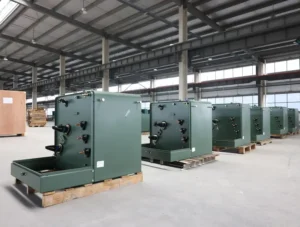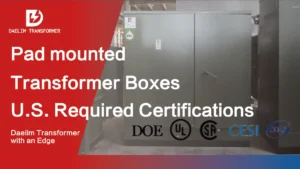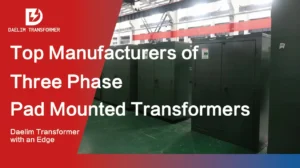This article will help you know power line transformer!

Power line transformer is connected to power generation and distribution system, the types include power pole transformer, pad mount transformer. Generally transformer on a power line is distribution transformer (check daelim distribution transformer). This article will introduce the knowledge of power line transformer.
Pad-mounted Transformer
Dry-type Transformer
Oil immersed transformer
Table of Content
What does a transformer do on a power line?
It depends on single phase pole mount transformer or three phase pole mount transformer. And also depends on the capacity, please check this link for more detailed information of our transformer.
Let’s know learn more about the EAF TRANSFORMER MEXICO
What are the requirements of installing the pole-mounted transformer?
Among the four links of power generation, transmission, distribution and consumption, power line transformer appear in the first three links.
First, in the power generation link, the power transformer transmits the electric energy generated by the power plant to the power grid, and increases the output voltage of the power plant to meet the requirements of the rated high voltage of the transmission power grid. The transformer used here is a step-up transformer.
Second, it is used for voltage transformation between grids of different voltage levels.
Third, at the end of power transmission, the voltage is reduced through power transformers at all levels to meet the voltage requirements of the distribution network.
Try for free information about the How to produce a distribution transformer ?
What happens to a transformer when it is first connected to a power line?
It will start to work.
How much does a power line transformer cost?
The design of power line transformer must first meet the requirements of relevant industry standards, and must also comply with the provisions of the contract. Generally, the contract of oil-immersed transformers should include the following technical standards.
(1) The form of the oil-immersed transformer: the number of phases, the number of windings, whether it is autocoupling, voltage transformation or blood pressure reduction;
(2) Rated capacity of oil-immersed transformers: For three-winding oil-immersed transformers or auto-coupled oil-immersed transformers, the rated capacity of each winding, or the rated capacity under different cooling methods, should be indicated;
(3) Refrigeration method of oil-immersed transformer;
(4) The rated voltage and voltage regulation method of the oil-immersed transformer: the rated voltage of high voltage, high voltage or bottom voltage is the voltage regulation of on-load voltage regulation or non-excitation regulator, as well as the range of taps and tap levels. If it is on-load voltage regulation, it should be marked as neutral line voltage regulation or line end voltage regulation;
(5) Other standards.
Read my article on How to Choose a Pad Mounted Transformer and Delta Wye Transformer?
Why do powerline transformers explode?
Generally, transformer explosions are also divided into internal and external causes. The internal causes are mainly insulation damage, poor contact, and short-circuit overheating of the load, while the external causes are mainly the transformer being struck by lightning, and the external fire caused the transformer to explode. Let’s talk about the reasons for transformer damage in detail.
(1) The insulation is damaged and the coil insulation is aging. Poor oil quality, too little oil, aging and damage to the iron core insulation, careless maintenance and damage to the insulation.
(2) Poor contact. Local overheating occurs, the coil insulation is damaged, short circuit or open circuit occurs, high temperature and arc are generated, the insulating oil is rapidly decomposed, a large amount of gas is generated, and the pressure increases sharply. The reasons are: loose bolts, weak welding, and damage to the tap changer contacts.
(3) Lightning strike overvoltage. The overvoltage generated by the lightning strike breaks down the insulation of the transformer, burns the transformer, and causes a fire.
(4) The load is short-circuited.
(5) Transformer overheating Overheating of the transformer will affect the service life (for example, the operating life of the transformer is 20 years under the normal operating temperature of 90°C; if the temperature rises to 105°C, the service life is 7 years; if the temperature rises to 120°C, the service life is only 20 years). 2 years), in severe cases, fuel injection combustion or explosion will occur. The reasons for the overheating of the transformer are: poor contact and high contact resistance; long-term severe overload operation, causing the coil to heat up; excessive voltage and increased iron loss (when the voltage increases by 10%, the iron loss will increase by 30% to 50%) ; The ambient temperature is too high and the ventilation is poor;
(6) The transformer is ignited by an external fire source. The transformer catches fire because the combustibles stacked around the transformer ignite the transformer or the transformer room after burning. The transformer explosion mentioned in this question is very likely to be caused by poor contact of the transformer, short circuit and overheating. Generally, if the transformer capacity is too small, it is easy to cause a small horse-drawn cart, and it is very easy to cause the transformer to be overloaded. Cause an explosion, so choose a transformer to consider the capacity.
How can power line transformers prevent oxidation?
When the oil-immersed transformer is in normal operation, the iron core vibrates. However, when the load changes of the oil-immersed transformer and the oil-immersed transformer itself have abnormality or failure, abnormal sound occurs. Pay attention to the normal sound, get familiar with it, you can easily detect the abnormal sound of the oil immersed transformer.
The rise or fall of the oil level of the oil-immersed transformer under normal conditions is caused by the temperature change, and the change is not too big. If the oil level drops sharply, even if the oil level cannot be seen from the oil level gauge, there is the phenomenon of oil leakage of oil-immersed transformers and oil leakage. This is due to the damage of the transformer oil tank, the loosening of the oil removal valve, the instability of the transformer cover, and the damage of the oil level gauge. On the low oil level accelerates the aging of the transformer oil, deteriorates the insulation condition of the transformer, and brings serious results. Therefore, it is necessary to check more, maintain more, and work hard in time. If the leak is serious, we will immediately stop the maintenance.
Oil-immersed transformers need to measure the oil-water interfacial tension (circle ring method). The fluidity of oil is expressed by viscosity. The lower the viscosity, the better the fluidity. The measurement of oil-water interfacial tension is not used to characterize oil. flow performance.
Ice damage for power line transformer
Line obstacles caused by the insulator string being bridged by ice and flashover, overloaded by icing on the ground wire, jumping off the ice on the ground wire, and insufficient electrical distance due to the slippage of the ground wire.
a) After the running line insulator is covered with ice, the leakage current of the insulator along the surface will gradually melt the inside of the ice layer, and the water on the surface of the insulator in the ice layer will penetrate, and the leakage current will increase and penetrate the surface of the upper and lower insulators, causing flashover tripping.
b) After the ground wire is covered with ice, the ice-covered galloping of the wire will occur. The long-term galloping of the wire will cause the damage of the wire spacer, the wear of the hardware, the reduction of the wire spacing, the damage of the insulator, the damage to the tower structure or the collapse of the tower.
c) De-icing jumps and uneven icing cause the tension difference of the conductors to pull down the neck of the tower and collapse the tower;
d) Ice flashes leave obvious flashover traces on 1-2 pieces of insulators at both ends of the insulator string.













